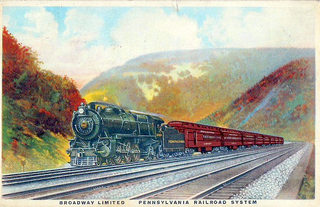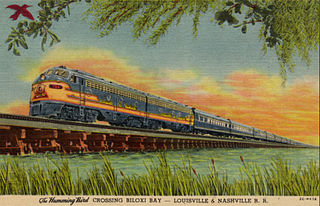
The New York Central Railroad was a railroad primarily operating in the Great Lakes and Mid-Atlantic regions of the United States. The railroad primarily connected greater New York and Boston in the east with Chicago and St. Louis in the Midwest, along with the intermediate cities of Albany, Buffalo, Cleveland, Cincinnati, Detroit, and Syracuse. New York Central was headquartered in New York City's New York Central Building, adjacent to its largest station, Grand Central Terminal.

The Broadway Limited was a passenger train operated by the Pennsylvania Railroad (PRR) between New York City and Chicago. It operated from 1912 to 1995. It was the Pennsylvania's premier train, competing directly with the New York Central Railroad's 20th Century Limited. The Broadway Limited continued operating after the formation of Penn Central (PC) in February 1968, one of the few long-distance trains to do so. PC conveyed the train to Amtrak in 1971, who operated it until 1995. The train's name referred not to Broadway in Manhattan, but rather to the "broad way" of PRR's four-track right-of-way along the majority of its route.

The City of Denver was a streamlined passenger train operated by the Union Pacific Railroad between Chicago, Illinois, and Denver, Colorado. It operated between 1936 and 1971. From 1936–1955 the Chicago and North Western Railway handled the train east of Omaha, Nebraska; the Chicago, Milwaukee, St. Paul and Pacific Railroad handled it thereafter. The train was the fastest long-distance train in the United States when it debuted in 1936, covering 1,048 miles (1,687 km) in 16 hours. For almost its entire career its principal competitor was the Chicago, Burlington and Quincy Railroad's Denver Zephyr. When Amtrak assumed operation of most intercity trains in the United States in 1971, it discontinued the City of Denver, preferring to use the Burlington's route between Chicago and Denver.

The El Capitan was a streamlined passenger train operated by the Atchison, Topeka and Santa Fe Railway between Chicago, Illinois, and Los Angeles, California. It operated from 1938 to 1971; Amtrak retained the name until 1973. The El Capitan was the only all-coach or "chair car" to operate on the Santa Fe main line between Chicago and Los Angeles on the same fast schedule as the railroad's premier all-Pullman Super Chief. It was also the first train to receive the pioneering Hi-Level equipment with which it would become synonymous.

The Denver Zephyr was a streamlined passenger train operated by the Chicago, Burlington and Quincy Railroad between Chicago, Illinois, and Denver, Colorado. In peak years it ran to Colorado Springs. It operated from 1936 to 1973. The Denver Zephyr continued operating after the Burlington Northern Railroad merger in 1970. BN conveyed the train to Amtrak in 1971; Amtrak merged it with the Denver–Oakland City of San Francisco to form the San Francisco Zephyr and dropped the "Denver" name in 1973.

The Chicago and Eastern Illinois Railroad was a Class I railroad that linked Chicago to southern Illinois, St. Louis, and Evansville. Founded in 1877, it grew aggressively and stayed relatively strong throughout the Great Depression and two World Wars before finally being purchased by the Missouri Pacific Railroad and the Louisville and Nashville Railroad (L&N). Missouri Pacific merged with the C&EI corporate entity in 1976, and was later acquired itself by the Union Pacific Railroad.
The Choctaw Rocket was a named passenger train operated by the Chicago, Rock Island and Pacific Railroad between Memphis, Tennessee, Little Rock, Oklahoma City, and Amarillo. Initially designated as train No. 51 (westbound) and train No. 52 (eastbound), it was the first diesel powered streamliner to operate out of Memphis, Tennessee, as well as the first streamliner service in the state of Arkansas.

The Panama Limited was a passenger train operated from 1911 to 1971 between Chicago, Illinois, and New Orleans, Louisiana. The flagship train of the Illinois Central Railroad, it took its name from the Panama Canal, which in 1911 was three years from completion. For most of its career, the train was "all-Pullman", carrying sleeping cars only. The Panama Limited was one of many trains discontinued when Amtrak began operations in 1971, though Amtrak revived the name later that year and continued it until 1981.

The Rocky Mountain Rocket was a streamlined passenger train of the Chicago, Rock Island and Pacific Railroad. Rock Island's train numbers 7 and 8 ran between Chicago's LaSalle Street Station and Denver's Union Station and Colorado Springs, Colorado. The Rocky Mountain Rocket ran from 1939 to 1966; the train was discontinued prior to the creation of Amtrak in 1971.

The Humming Bird was a named train of the Louisville and Nashville Railroad (L&N). The train, inaugurated in 1946, originally ran from Cincinnati, Ohio, to New Orleans, Louisiana, via Louisville, Nashville, Birmingham, Montgomery and Mobile and later via a connection at Bowling Green, Kentucky, to Memphis, Tennessee. A connection to Chicago was provided by the Chicago and Eastern Illinois Railroad. It had separate sections in the north and the south. The main northern part originated in Cincinnati; other sections originated in St. Louis and from Chicago. These sections linked with the main part of the train in Nashville. To the south, a connecting train option in Flomaton, Alabama offered train travel to Pensacola, Florida.

The City of Miami was a seven-car coach streamliner inaugurated by Illinois Central Railroad on December 18, 1940. Its route was from Chicago to Miami a total distance of 1,493 miles (2,403 km).

Mercury was the name used by the New York Central Railroad for a family of daytime streamliner passenger trains operating between midwestern cities. The Mercury train sets were designed by the noted industrial designer Henry Dreyfuss, and are considered a prime example of Streamline Moderne design. The success of the Mercury led to Dreyfuss getting the commission for the 1938 redesign of the NYC's flagship, the 20th Century Limited, one of the most famous trains in the United States of America.
The Whippoorwill was a short-lived passenger train operated by the Chicago and Eastern Illinois Railroad (C&EI) between Chicago, Illinois and Evansville, Indiana.

The Dixie Flagler was a streamlined passenger train operated by the Florida East Coast Railway (FEC) between Chicago, Illinois and Miami, Florida. It began in 1939 as the Henry M. Flagler, a regional service between Miami and Jacksonville, Florida; the FEC renamed it and extended it to Chicago a year later. It was one of the few Chicago to Florida trains that passed through Atlanta. As an overnight streamliner it was part of the every-third-day pool shared by the City of Miami and South Wind. It was renamed Dixieland in 1954 and discontinued altogether in 1957.

The Pere Marquette was a streamlined passenger train operated by the Pere Marquette Railway and its successor the Chesapeake and Ohio Railway (C&O) between Detroit and Grand Rapids, Michigan. It operated from 1946 to 1971. It was the first new streamliner to enter service after World War II. Although discontinued in 1971 on the formation of Amtrak, in 1984 Amtrak revived the name for a new train between Chicago, Illinois and Grand Rapids.

The Green Diamond was a streamlined passenger train operated by the Illinois Central Railroad between Chicago, Illinois and St. Louis, Missouri. It operated from 1936 until 1968. It was the Illinois Central's first streamliner. Initially it operated with Illinois Central 121, the last of the 1930s fixed-consist articulated streamliners built in the United States.

The Sun Lounges were a fleet of three streamlined sleeper-lounge cars built by Pullman-Standard for the Seaboard Air Line Railroad in 1956. The cars featured a distinctive glazed roof area meant to capture the ambience of a dome car in a lower profile, as tunnels on the East Coast of the United States prevented the use of dome cars there. The Seaboard employed all three Sun Lounges on its flagship Silver Meteor between New York City and Miami, Florida. The cars later saw service with the Seaboard Coast Line Railroad and Amtrak. Two of the three survive in private ownership.

The Dixie Flyer was a premier named passenger train that operated from 1892 to 1965 via the "Dixie Route" from Chicago and St. Louis via Evansville, Nashville, and Atlanta to Florida. However, the train persisted to 1969 as an Atlanta to Florida operation, solely run by the Atlantic Coast Line Railroad and its successor. The Flyer's route varied in early years, but by about 1920 was set as follows:
The Georgian was a long distance passenger train operated by the Louisville and Nashville Railroad in conjunction with the Chicago and Eastern Illinois Railroad. It was operated between St. Louis St. Louis Union Station and Atlanta's Atlanta Union Station with a section operated by the C&EI from Evansville to Chicago's Dearborn Station. From Nashville to Atlanta it operated over the tracks of the Nashville, Chattanooga and St. Louis Railway. With the introduction of this train, this made the C&EI's Chicago-Evansville Whippoorwill train superfluous.

The Hoosier was a passenger train operated by the Chicago, Indianapolis and Louisville Railway (Monon) between Chicago, Illinois and Indianapolis, Indiana. It operated from 1911 to 1959. A Hoosier is a resident of the state of Indiana.

















